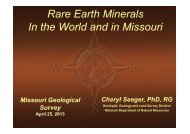You also want an ePaper? Increase the reach of your titles
YUMPU automatically turns print PDFs into web optimized ePapers that Google loves.
Precambrian occurrences<br />
Precambrian rocks across Wyom<strong>in</strong>g are potential<br />
hosts of REE. Known occurrences are present<br />
with<strong>in</strong> granitic igneous rocks and with<strong>in</strong> metamorphic<br />
rocks of various compositions (fig. 4). The<br />
most important Precambrian REE-host rocks <strong>in</strong><br />
Wyom<strong>in</strong>g are granitic pegmatites and other pods<br />
and dikes with<strong>in</strong> granitic igneous and metamorphic<br />
rocks. These <strong>in</strong>clude granitic pegmatites with<strong>in</strong> the<br />
Mesoproterozoic Sherman Granite near Tie Sid<strong>in</strong>g<br />
<strong>in</strong> southeastern Wyom<strong>in</strong>g, granitic pegmatites that<br />
cut Paleoproterozoic granite gneiss <strong>in</strong> the Big Creek<br />
district on the west flank of the Medic<strong>in</strong>e Bow<br />
Mounta<strong>in</strong>s, and calc-silicate pods and dikes with<strong>in</strong><br />
Archean granitic gneiss <strong>in</strong> the southern Bighorn<br />
Mounta<strong>in</strong>s. Secondary alteration <strong>in</strong> some pegmatites<br />
is apparently important <strong>in</strong> concentrat<strong>in</strong>g REE.<br />
Pegmatites<br />
Globally, granitic pegmatites host important deposits<br />
of strategic resources. Strategic resources are<br />
<strong>elements</strong> that are important for a country’s economy<br />
or defense, but have substantial risk of supply<br />
disruptions (Adams and others, 1980; L<strong>in</strong>nen and<br />
others, 2012). Strategic resources commonly hosted<br />
<strong>in</strong> granitic pegmatites <strong>in</strong>clude Ta, Nb, Be, Sb, W,<br />
Co, and REE. Two general types of pegmatites<br />
that are important hosts of strategic resources are:<br />
1) Lithium-Cesium-Tantalum (LCT) pegmatites,<br />
which conta<strong>in</strong> high concentrations of Li, Cs, Ta, P,<br />
B, Rb, Be, Nb, and Sn; and 2) Niobium-Yttrium-<br />
Fluor<strong>in</strong>e (NYF) pegmatites, which are enriched <strong>in</strong><br />
niobium, yttrium, and fluor<strong>in</strong>e, as well as the REE<br />
(L<strong>in</strong>nen and others, 2012). The LCT pegmatites<br />
currently have greater economic importance than<br />
the NYF pegmatites (L<strong>in</strong>nen and others, 2012).<br />
However, the economic potential of the NYF pegmatites<br />
to produce REE resources is demonstrated<br />
by the Strange Lake pegmatite <strong>in</strong> Canada, which<br />
hosts more than 140 million tonnes (154.3 million<br />
tons) of ore with an average grade of 0.9 percent<br />
TREO (Quest Rare M<strong>in</strong>erals, 2013).<br />
LCT and NYF pegmatites typically occur with<strong>in</strong><br />
granitic <strong>in</strong>trusive complexes (L<strong>in</strong>nen and others,<br />
2012). However, REE-bear<strong>in</strong>g pegmatites are also<br />
present with<strong>in</strong> metamorphic terra<strong>in</strong>s, as pods and<br />
dikes that can be discordant to foliation, as well<br />
21<br />
as small lenses concordant to foliation (Houston,<br />
1961; Adams and others, 1980).<br />
Across Wyom<strong>in</strong>g, granitic pegmatites are potential<br />
hosts for both high- and low-grade REE-m<strong>in</strong>eralization.<br />
Significant enrichment is present <strong>in</strong> the<br />
Big Creek and Tie Sid<strong>in</strong>g districts, and <strong>in</strong>terest<strong>in</strong>g<br />
REE or other element anomalies occur <strong>in</strong> the<br />
Weddle claims, the Many Values area, and <strong>in</strong> the<br />
Allie claims. For granitic pegmatites hosted with<strong>in</strong><br />
<strong>in</strong>trusive rocks, post-emplacement processes may<br />
be important factors controll<strong>in</strong>g the concentration<br />
of REE. In the Tie Sid<strong>in</strong>g area (fig. 5), post-emplacement<br />
hydrothermal activity was apparently responsible<br />
for further concentration of REE with<strong>in</strong><br />
alteration zones (fig. 6). In the Weddle claims <strong>in</strong><br />
the Laramie Range, the only notable REE-enrichment<br />
is associated with a granite dikelet, re<strong>in</strong>forc<strong>in</strong>g<br />
the importance of post-emplacement processes<br />
<strong>in</strong> concentrat<strong>in</strong>g REE. However, the secondary<br />
processes appear to be less important for REEenrichment<br />
<strong>in</strong> pegmatites hosted by metamorphic<br />
rocks. However, <strong>in</strong> the Allie claims <strong>in</strong> the southern<br />
Bighorn Mounta<strong>in</strong>s, field relations suggest that the<br />
pegmatite bodies are the product of partial melt<strong>in</strong>g<br />
of the host-rock gneiss.<br />
tie sid<strong>in</strong>g Pegmatites<br />
Pegmatite pods with<strong>in</strong> the Sherman Granite southeast<br />
of Tie Sid<strong>in</strong>g (fig. 5) can be highly radioactive<br />
and enriched <strong>in</strong> some REE (K<strong>in</strong>g and Harris,<br />
2002). The Tie Sid<strong>in</strong>g pegmatites are typically<br />
zoned, and have an overall alkali feldspar granite<br />
composition. Zonation consists of an outer zone<br />
composed of biotite, microcl<strong>in</strong>e, and quartz, a central<br />
zone that is more than 90 percent microcl<strong>in</strong>e,<br />
and an <strong>in</strong>ner core of quartz (Griff<strong>in</strong> and Warner,<br />
1982). Many of these pegmatites exhibit fresh<br />
exposures due to production of potassium feldspar<br />
<strong>in</strong> the 1940s (fig. 6) (Osterwald and others, 1966;<br />
Griff<strong>in</strong> and Warner, 1982).<br />
The REE-bear<strong>in</strong>g m<strong>in</strong>erals with<strong>in</strong> some of these<br />
pegmatites are uncerta<strong>in</strong>, but allanite is present <strong>in</strong><br />
at least one locality, and zones of elevated radioactivity<br />
(7 – 500 times background) are present at<br />
all of the studied pegmatites (Griff<strong>in</strong> and Warner,<br />
1982). The highest levels of radioactivity are associated<br />
with biotite. Griff<strong>in</strong> and Warner (1982)



